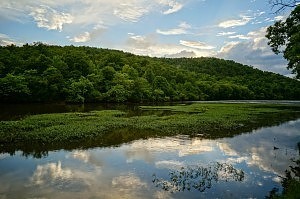Groups Urge Full Protection of Tributaries and Adjacent Waters in WOTUS Rule
By: Waterkeeper Alliance

Broad, clear definition of “Waters of the U.S.” critical to protecting our waterways
Waterkeeper Alliance submits comments to EPA and U.S. Army Corps of Engineers urging full protection of tributaries and adjacent waters
NEW YORK, NY — November 19, 2014 — Waterkeeper Alliance has submitted comments along with 54 other Waterkeeper organizations across the country on the proposed definition of “waters of the United States” (WOTUS) under the Clean Water Act (CWA). The groups’ comments are in response to the sweeping changes the U.S. Environmental Protection Agency (EPA) and U.S. Army Corps of Engineers (Corps) proposed on April 21, 2014. Only waters that are included within the definition can be protected under the core water quality protections and pollution prohibitions of the CWA.
Waterkeeper Alliance and Waterkeeper organizations support the proposed rule to the extent that it maintains protections for traditionally navigable waters, interstate waters and territorial seas. Additionally, the groups strongly support the protection of certain headwater streams, intermittent streams, ephemeral streams, and adjacent waters that the agencies have determined have a “significant nexus” to downstream protected waters.
However, the groups oppose the agencies’ decision to narrow CWA jurisdiction over historically protected waters, including tributaries, adjacent wetlands and other waters, through unprecedented regulatory definitions, legal theories and categorical exemptions. The groups urge the EPA and the Corp to restore CWA protections to all historically protected waters and to maintain all valid jurisdictional bases for doing so.
Additionally, the groups urge EPA to remove categorical exemptions that may allow major polluting industries to avoid complying with CWA protections – such as Coal-Fired Power Plants that impound waterways for storage of toxic coal ash and Industrialized Swine Feeding Operations that discharge untreated animal sewage through ditched and channelized streams. Many of the proposed categorical exemptions, which apply even if the water would otherwise qualify as a navigable water, interstate water, or tributary, are directly related to major, unaddressed pollution problems that exist across the country, affect major waterbodies of national importance, and affect the health and safety of countless people.
“Given the most recent crisis with the drinking water supply in Toledo, it is mystifying that the agencies would propose exempting waters that are known to contribute substantial amounts of algae-producing pollution to downstream waters,” said Marc Yaggi, Executive Director of Waterkeeper Alliance. “We can have a strong agricultural sector and clean water, but not if the EPA disregards the best available science and categorically exempts these waters from the CWA to satisfy industrial agribusiness advocates.”
The waste disposal practices of large agribusiness corporations that have industrialized meat production in the United States are well-known sources of pollution in key water resources like Lake Erie, the Chesapeake Bay, the Gulf of Mexico, North Carolina’s coastal estuaries, and many other significant water resources across the country. Pollutants are often discharged from these facilities to ditches, ditched streams and channelized streams that transport large amounts of pollution to downstream waters. Since 1998, the states have consistently reported to EPA that agricultural sources, including CAFOs, are a leading source of nutrient and pathogen pollution in waters across the United States, with animal waste discharges causing fish kills and fish consumption advisories, algal blooms, contamination of drinking water sources, and transmission of disease-causing bacteria and parasites associated with food and waterborne diseases.
“Maintaining coverage for waters that have long been protected under the Clean Water Act is essential for safeguarding public health and the environment, including drinking water supplies, recreational users and fisheries,” stated Kelly Foster, Senior Attorney at Waterkeeper Alliance. “The narrowing of jurisdiction proposed by the EPA and the Corps is not supported by sound science or legal precedent.”
Waterkeeper Alliance and the Waterkeeper Organizations called upon the EPA and the Corps to ensure that the new definition:
-
Includes all waters that have historically been protected under the CWA and the existing definition.
-
Does not narrow jurisdiction or limit the legal bases for asserting jurisdiction over historically protected waters.
-
Fully ensures jurisdictional coverage of all impoundments, tributaries and adjacent waters.
-
Does not contain definitional requirements or categorical exemptions that are inconsistent with law and the science.
-
Does not categorically exempt “ditches” – an undefined term that could encompass historically protected waterways that contribute substantial pollution to downstream waters.
-
Retains the categorical protection for “other waters” the use, degradation or destruction of which impact interstate commerce, in addition to “other water” with a significant nexus to downstream waters.
-
Does not categorically exclude groundwater and waterways that have been converted into waste treatment systems.
“We understand and have seen firsthand how important a clear definition of the ‘waters of the U.S.’ is to the functioning and effectiveness of the CWA,” added Mr. Yaggi. “Simply put, a waterbody not included within the definition will not be protected from pollution or destruction under the CWA, potentially setting us back 42 years in the Act’s goal of achieving swimmable, fishable waters.”